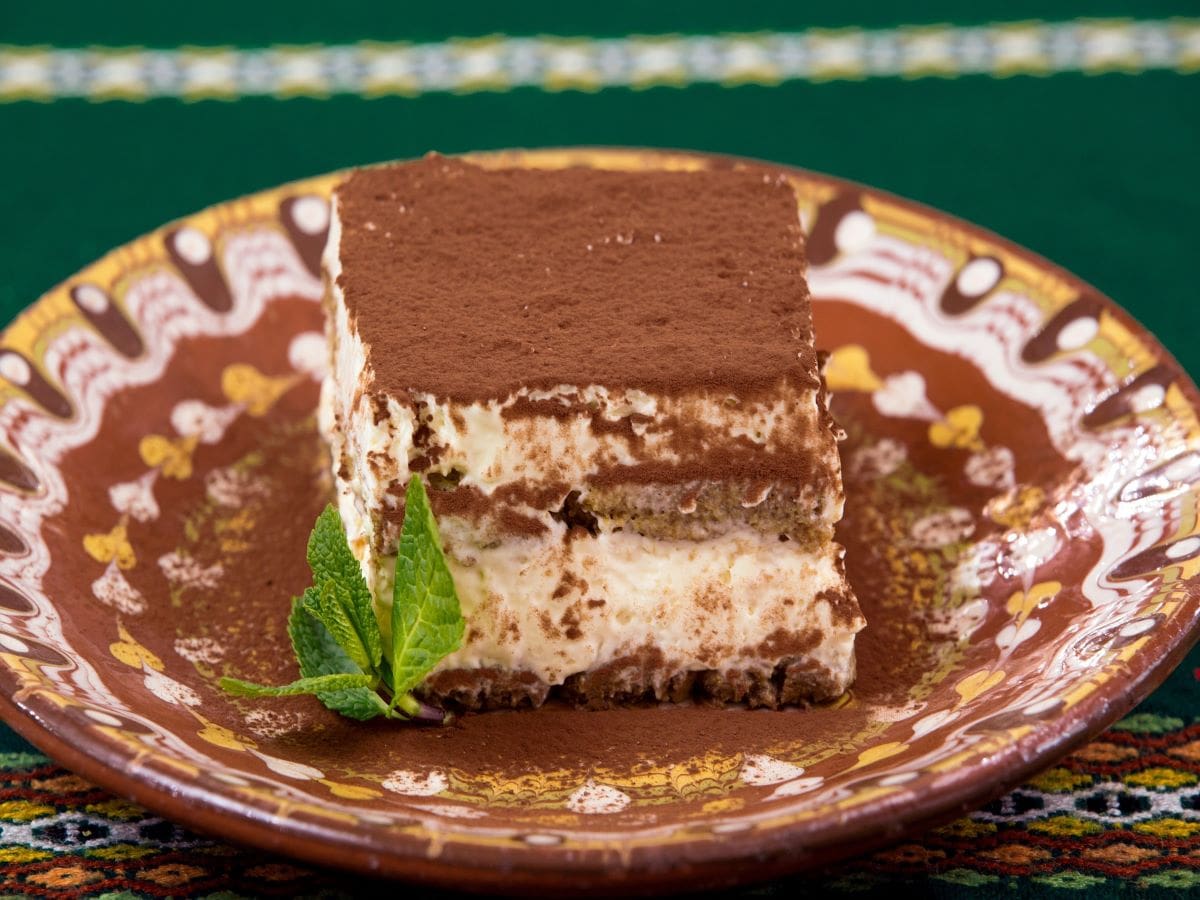Tiramisù may be Italy’s most well-known dessert, but for me, it has been full of surprises.
Before living in Italy, I thought I knew what tiramisù was. I had tried it in a few restaurants, and my mom sometimes brought it home frozen from the grocery store. To me, tiramisù was a semi-frozen dessert rich with coffee and rum, often with a questionable consistency. I was convinced that I didn’t like it.
When offered tiramisù at my first dinner party in Italy, I politely declined … until I saw it. The soft, creamy dessert being passed around on plates looked very different from the rigid, stodgy slices that I knew. I changed my mind and decided to try it. WOW … that’s all I could say. Over my second helping, my friends shared the recipe with me.
Traditional tiramisù is made with eggs, sugar, mascarpone, savoiardi cookies, espresso, and cacao powder.
Until tasting my friends’ tiramisù, I realized that I had severely misjudged the dessert based on the non-authentic versions I’d tried. Real tiramisù did not have ingredients like cream cheese, whipped cream, or rum. Real tiramisù was not supposed to be frozen but, instead, refrigerated and promptly enjoyed. Real tiramisù was smooth and flavorful.
Although there is a right way to make authentic tiramisù, one of the best parts about the dessert is that it can be so easily customized. Just about every Italian I know has their own take on the recipe. You can get really creative with it. The best versions I have had, though, don’t depart too much from traditional ingredients.
One memorable evening, my friends organized a tiramisù-making competition. Interestingly, even the tiramisùs made exclusively with traditional ingredients still tasted very different from each other. Variations stemmed from how long the savoiardi had been soaked in espresso, how much the cream had been whipped, how dark the cacao was, etc. Satisfying modifications included adding chocolate flakes to the cream, substituting thinner Pavesini cookies for savoiardi, using pan di spagna instead of savoiardi. I could not choose a favorite.
I have continued to taste many tiramisùs over the years. I find it on menus all around Italy. Whenever organizing a potluck with my Italian friends, someone always ends up bringing one. It is truly a pick-me-up – just as the name tiramisù means.
Because of its widespread presence in Italy and around the world, I was surprised to learn that tiramisù is a recent addition to Italian culture - invented in the second half of the twentieth century.
Although the exact history of tiramisù is contested, there are two theories believed to be most probable.
The first story identifies Friuli-Venezia Giulia as the birthplace of tiramisù. In 1951, hotel-owner Norma Pielli allegedly modified an egg-based cream recipe documented by food writer Pellegrini Artusi to include marscarpone and savoiardi dipped in espresso. Pielli’s husband, Giuseppe Del Fabbro, called the recipe tiramisù because it was energizing and delicious.
The other main story attributes the invention of tiramisù to a pastry chef by the name of Roberto Linguanotto from the Veneto region. While working at Le Beccherie restaurant in Treviso, Linguanotto supposedly wanted to create a family-friendly dessert. He took inspiration from ‘sbadutin’ – a traditional recipe from the Veneto consisting of raw eggs beaten with sugar. In 1972, tiramisù first appeared on the menu at Le Beccherie. Because the region of Veneto so vehemently defends this story, this is the version I’m going with.
If you’d like to learn more about the history of tiramisù, Gigi and Clara Padovani have written an interesting book in Italian on the topic: Tiramisù.Storia, curiosità, interpretazioni del dolce italiano più amato. Despite the mysteries surrounding the invention of the dessert, there is one undeniable certainty. Tiramisù is just so good that it took less than a century to take its place as Italy’s most prominent dessert.

Italian Vocabulary related to Tiramisù
All Around Italia helps you learn about Italy and also learn Italian! Here are some words related to Erice. Have you heard these before?
la pirofila – baking dish, casserole tray
Al solito si fa il tiramisù in pirofila o in coppette monoporzione. / Usually tiramisù is made in a baking dish or single-serve cups.
Il contendente – contender
Ci sono due vere contendenti per il luogo di nascita’ del tiramisù: le regioni Veneto e Friuli- Venezia Giulia. / There are two real contenders for the birthplace of tiramisù: the regions of Veneto and Friuli-Venezia Giulia.
Montare a neve – beat/whisk to form stiff peaks (when baking)
Per ottenere la giusta consistenza della crema del tiramisù, montate a neve gli albumi prima di unirli ai tuorli montati con lo zucchero. / To obtain the right consistency of the tiramisù cream, beat the egg whites to form stiff peaks and add them to the egg yolks beaten together with sugar.
Make Tiramisù
Bring Italian into your everyday life by making tiramisù.
Making Italian treats is an easy and delicious way to add some Italian culture to your life (and share with friends). I’ve shared recipes for desserts such as Granita Sicliana, Baci di Dama cookies, Baci di Alassio cookies, and more. Now, it’s time for our traditional tiramisù recipe.
Our friend, Ettore, proudly shared this recipe with us years ago. It won’t win any awards for the healthiest tiramisù as it uses more eggs than other versions … however, it is always a huge hit.
As I do not give my toddler coffee in any form (I did once by mistake – never again!!!), we dip the savoiardi for her portion of the tiramisù in milk with cacao dissolved in it. A very satisfying, kid-friendly replacement – that sometimes I even prefer to the espresso.
Ingredients
6 egg yolks (pasture-raised eggs)
3 egg whites (use the extra egg whites to make Baci di Alassio)
500 grams of good-quality mascarpone cheese
120 grams of white sugar
3-4 espresso cups worth of good-quality espresso
1 package of savoiardi, or lady finger, cookies (about 30 cookies)
50 grams of good quality dark cacao
Kitchen Tools
Electric mixer
Preparation
Separate out 6 egg yolks and 3 egg whites. Put the egg whites in the refrigerator while you work on the other parts of the recipe.
Make the espresso and add it all to a bowl. Let it cool. (For the kid-friendly substitute, dissolve a tablespoon of cacao in hot milk and add to a bowl.)
Beat together the 6 egg yolks and 120 grams of sugar. Beat in the 500 grams of marscarpone. Create a uniform cream.
Take the 3 egg whites out of the refrigerator. Beat them until they form stiff peaks.
Gradually add the beaten egg whites into the cream, mixing slowly and carefully from bottom to top.
Very quickly dip both sides of the savoiardi in the espresso (and/or chocolate milk) and place them tightly next to each other in a casserole dish (roughly 15 inches by 12 inches or 38 cm by 30 cm). The cookies should not be soggy, just lightly wet. On top of each layer of cookies, add a generous layer of cream.
You should be able to get 2 or 3 layers of cookies. On the top, use a sifter to spread the cacao lightly over the top.
Cover and refrigerator the tiramisù for at least 4 hours.
Share with family or friends, and enjoy! Be prepared for an energy-burst after eating. It truly is a pick-me-up! Buon appetito!
In the comments below, let us know if you try the recipe out. Buon appetito!


